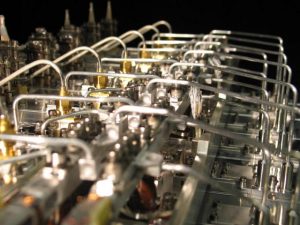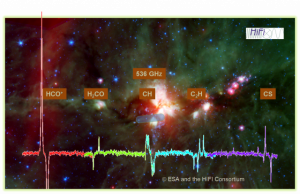
After a number of months offline, the third of Herschel’s instruments is back online. HIFI, which is a high resolution spectrometer has recently been turned back on after being shut down by a fault in early August 2009. After months of effort to understand the problem and ensure that it does not happen again, the instrument team have now got it back into working order and are ready to continue with its mission.
HIFI is a spectrograph, splitting the light into a range of wavelengths and detecting the “fingerprint” of individual elements and molecules in space. While Herschel’s other two instruments, SPIRE and PACS, both have spectrometers, HIFI can split the light up much more finely, even detecting the speed with which gas and dust are moving in other galaxies.
The problem
On 3rd August, an error was reported on one of the control units of HIFI, causing a sharp change in power which damaged the unit beyond repair. The reason for the fault is likely to have been an energetic cosmic ray, a particle moving close to the speed of light which originated either in the Sun, from an energetic event in our Galaxy, or maybe even from another galaxy. These cosmic rays impact all satellites, but don’t normally bother us on the surface of the Earth because of our planet’s magnetic field which deflects the particles and protects us from their potential damaging effects. Herschel, 1.5 million km from Earth, has no such protection, but even so the chances of such a particle hitting at just the right time and in just the right places are minimal.
The cosmic ray hit part of the “Local Oscillator Control Unit” on HIFI, and caused the error message which resulting in the unit rebooting, losing contact with the instrument’s main computer, and then a short time later going into standby mode. Because it was powered on when it entered standby mode, a large voltage was sent through the system which fatally damaged a component in the control unit’s power supply. Luckily, no other parts of the instrument or satellite were damaged, and there is a spare control unit on board – just in case something unexpected like this happens. The software which controls HIFI, and was responsible for putting it into standby mode, has been updated such that a similar thing cannot happen again, though HIFI is now using a backup control unit and so is without a spare if anything does go wrong.
The HIFI instrument team, lead by Principal Investigator Frank Helmich, who said “this is really thanks to the great efforts made by all of the researchers at ESA, SRON and the HIFI partners, who have worked together as a single team. The motivation to crack this problem came from the depths of the professional pride of the staff themselves. While I hadn’t expected anything else, I’m really very proud of this.”
More information is provided on the HIFI website at SRON, Netherlands.
A promising future

The ability of HIFI to detect many different molecules will be incredibly useful for understanding how stars form. This image of a region called “DR21” towards the constellation of Cygnus shows a number of key organic molecules: formaldehyde (H2CO), carbon sulfide (CS), the formyl ion (HCO+), the ethynyl radical (C2H), the methyladyne radical (CH). After a period of commissioning and science demonstration, allowing HIFI to catch up with the impressive progress of SPIRE and PACS, HIFI will begin its science mission. Many of the observations HIFI will conduct are only possible from space because the Earth’s atmosphere normally absorbs light at these wavlengths. After what must have been a very tense period, Peter Roelfsema, HIFI project leader, said “there are no certainties in space research; instruments that have to do precision work in the hostile environment of space will always be vulnerable. But we are confident that HIFI can now carry out all scientific observations.”
